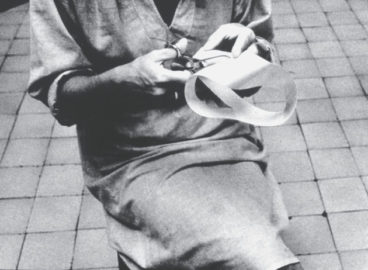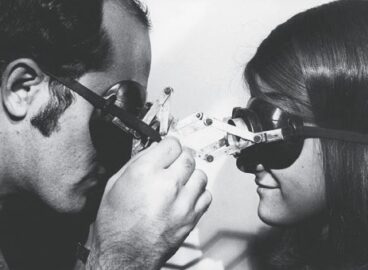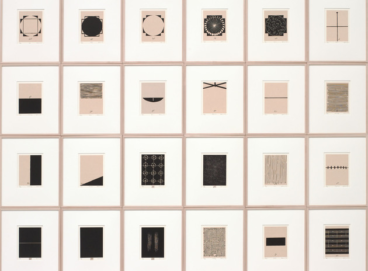Through Brazilian musician Caetano Veloso to ancient Roman philosopher Pliny the Elder, scholar Luis Pérez-Oramas outlines and contextualizes Brazilian artist Lygia Clark’s vast body of work. The third and final section of this essay connects the sculptural nature of Clark’s paintings and the human body’s activation in her later works.
In addition to the essay by Pérez-Oramas, you can access installation views and the press release through MoMA’s online exhibition history archive here.

Invoking another archaeology of the arts, the line in Caminhando neutralizes an old operational dialectic that seems to have regulated the aesthetic imaginary of the West at least since the Renaissance. This dialectic—or this opposition, this binary tension—appears in Leonardo’s comparison of painting and sculpture: painting, he says, works via di pore (by placing), adding material to material, putting paint where it was not before, while sculpture works via di levare (by removing), subtracting material from material, cutting stone out of the block to find the form hidden within.1See Jacqueline Lichtenstein, La Tache aveugle. Essai sur les relations de la peinture et de la sculpture à l’âge modern (Paris: Gallimard, 2003), p. 16. This distinction might seem to have been outdated by the novelty and hybridity of modern art, but we arguably see a modern via de levare in the aesthetic argument that marked an end of modernism proper in the 1960s, the same period in which Clark abandoned art in her work: the shift from authorship to spectatorship, and the replacement of physical material by informational material, that is, the well-known idea that so-called conceptual art involved a dematerialization of the art object. Leonardo’s distinction, then, continued to bear on the imaginary, even half a millennium after he articulated it.

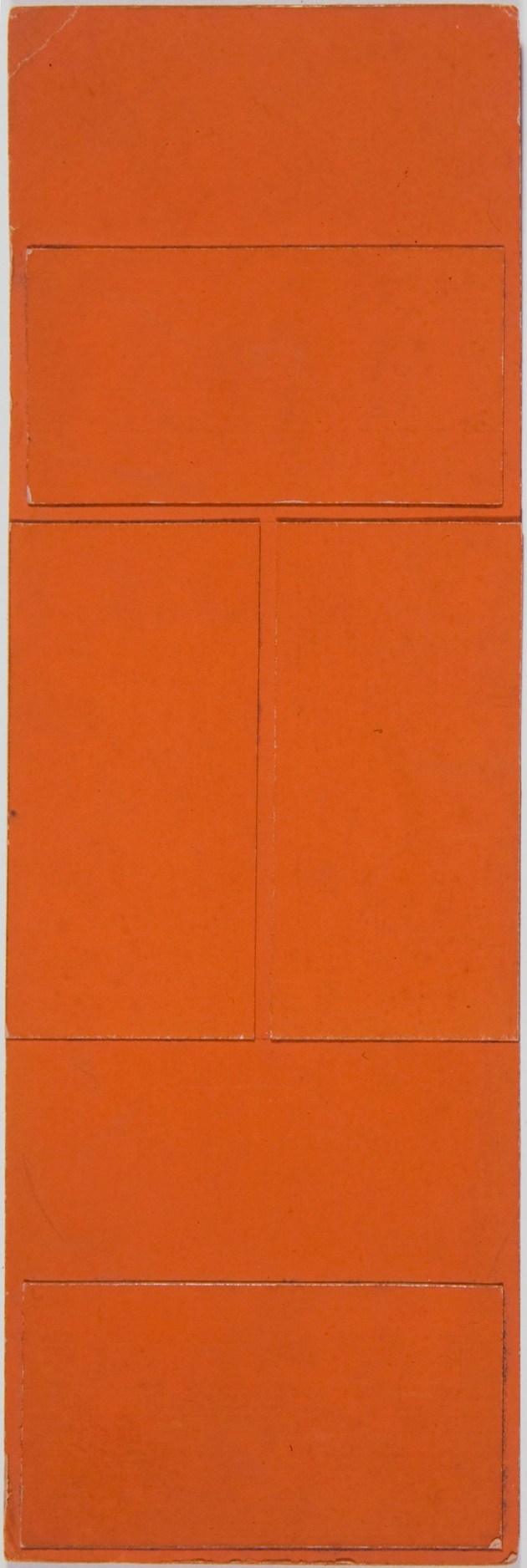
It would be reasonable to think that Clark’s pictorial maneuver in discovering the organic line responded conceptually to the matrices of sculpture, to the via di levare—that in order to produce this incision, this line that is a space, she took material from material, or at least avoided material and exposed it through its absence. Yet the Superfícies moduladas, Espaços modulados, and Planos em superfícies moduladas and more particularly the studies for those works from 1957 to 1959, which display the enormous repertory of her organic line, indicate a material and operative persistence of the via di porre: an adding of plane to plane, a filtering of strata from surfaces to emphasize their quality of agglomeration, a displacement of juxtaposed fields of color to bring out their density. These works involve less the removal of some of the support than its elevation, plane by plane, modulation by modulation. The work is built up like a structure until there emerges a functional line of division, a limit-line, a minus-line, a line that is a space.
We might suppose—were it not a near-meaningless statement of the obvious—thatCaminhando, like its direct consequence in Clark’s work, O dentro é o for a, is a sculpture, and that all her later objects through Livro-obra (Book-work) of 1984 are also sculptures, were it not for the fact that they only exist relationally and as they are activated. Rather than sculptures, they are really bodies or things. Similarly, everything would seem to indicate that materially and operatively, the action that produced Caminhando responded to the logic of the via di levare, that is, to the matrix of sculpture within humanist thought (if it weren’t for Pliny’s story of Butades, as we will see). Yet the result, the effect, the remainder or residue ofCaminhando is additive, a prodigious accumulation and multiplication of the material diversity embedded in the unity of the plane, which for Clark was “the thickness of space.”2Clark, fragment (“Sobre o espaço”), 1957. Archives of the Associaçao Cultural “O Mundo de Lygia Clark.” From this density, and without either subtracting from or adding to it in the least, Caminhando produces a mass of paper lines, which grow thinner and thinner until the paper’s own material presence becomes infra-light. Conceptually if not physically, this operation corresponds to the via di porre, to the archaeological matrix of painting.
This complex system of oppositions seems key to understanding the legacy of Clark’s work, and beyond that its origin. Caminhando neutralizes the tension between the via di levare and the via di porre that has been foundational to the Western visual imaginary; it ends a formal dialectic that has regulated visual production, and does so without either emphasizing or stigmatizing its material, without turning to the sophism of the “dematerialization of the artwork.” It neither subtracts from nor adds to the material of the world, and paradoxically, prodigiously, it produces a new being, a new instance of form, a continuous generated form that lacks form, not an addition but a pure accumulation and remainder, a multiplied indivisible line that lives in the potential of the unitary and the dense, without suffering the drama of fracture or the abyss of separation.
The light that Clark’s work projects onto the obscure prehistory of painting—onto its archē—is thus tremendous. Caminhando shows us why Pliny’s crucial text locates the origins of painting in the delay, difference, and deferral (simultaneously narrative and conceptual) that appear in a story of modeling, an act of via di porre—the potter Butades’s use of formless clay to cover an infra-light figure, a line describing the shadow of a body withdrawing, his daughter’s lover moving into the distance. This origin myth of painting as subject to metamorphosis and alteration hides a moral and existential question, one that modern readers of Pliny tend to forget: it is ultimately because of the imminence of a separation, an absence, a loss, that painting is “invented,” when the line of the contour of the shadow of the face of a girl’s lover is traced an instant before the two part. It is the imminence of the lover’s absence, as much as his isolate presence, that creates the possibility of this infra-light shadow, this infra-thin corporeal exhalation, and with it the desire for the line that encloses it, as if embracing it, as if caressing it, as if enclosing the shadow might allow the girl to touch the body that absents itself, that separates itself and departs—to touch it before another body, a grafted alien bulge, a dry poultice with no pulse of life, comes vicariously to substitute for it as a representation.
For Clark, painting was never a shadow: in other words, and to further activate this interplay with Pliny that I’ve made a ritornello, in her work painting was never motivated by the absence of a body. Yet it was the absence of a body—the multiple, various, uncountable absences of the bodies of others as well as the absence of her own body, her sense of what she jarringly called “nostalgia of the body”—that constituted the original, incessant, inexhaustible, and final problem that Clark addressed as an artist. It was this “nostalgia of the body”—the opposite of a body emerging from the body of painting—that was her true obsession and the motive for her art, the question she seems to have addressed, elaborated, revisited, and transformed incessantly in her work throughout her life, and that constitutes her artistic legacy today. “I think,” Clark wrote, “that a painting is always an experimental field for the seeking out of new spaces and authentic spiritual necessities.”3Clark, “Lecture at the Escola Nacional de Arquitetura, Belo Horizonte, Fall 1956,” p. 54.
In fact there is nothing visually “organic” in Clark’s organic lines. They are “organic” because they lie within the material organism in which they exist; they do not originate elsewhere, nor can they be traced as abstract artifices—they take place at the site of what they perforate or separate. Insofar as they fissure, excavate, or split the materiality of the picture plane—actions that translate into an empirical demonstration of its density, its body—they are inductive vectors indexing the body of painting. In other words, the organic line is also a mnemonic line: suddenly and unexpectedly, it reminds us that painting is and always has been a body—a body, another body, between us and others; a body that harbors other bodies, if only in infra-thin shape. Ultimately the organic line also reminds us that life unfolds, actualizes, materializes, becomes present, through separation, failure, absence, discontinuity, interruption. We might think, then, that this demonstration of the body of painting was the condition of possibility that allowed Clark to focus on her own absent body, allowed her to imagine, name, and signal her “nostalgia of the body.” When her organic lines allowed her to uncover the inevitable, weighty reality of the body of painting, they functioned as indications, or vindications, of a body— of her body—and of ours.
Functional lines, vindicating lines, effective lines—different from one another, indeed almost opposites—one made of absence or zero-degree presence, another of pure presence, pure action. From her discovery of the organic line toCaminhando, Clark’s lines suggest a performative dimension, and perhaps a sacramental one to which I believe she aspired from the start. This sacramental dimension—effective, active, rather than purely a realm of the signifier—has to do with the experience of origination and separation, and with elements such as the gaps or syncopes of forgetting, with trauma, remembrance, and dream, with repression and the return of the repressed. This territory seems to have constituted the ground of all of Clark’s work. Her Objetos sensoriais— the paraphernalia of her work on what she called nostalgia of the body, fantasmatics of the body, or structuring of the self—aspired to be signs as much as causes, and as they mediate a complex process of personal decision-making, of convocation and acceptance, they become what they are only insofar as they effectively make what they represent—insofar as they do not stop at signification. Often, if not always, they are like pure signifiers, but beyond what they might signify, they indicate or vindicate an unattainable reality that is covered over or hidden in forgetting, and that belongs to no concrete past but precedes us in our divided being, in what we fragmentarily have been.
What this might be is not mine to name, since naming it is probably impossible, and risks caricaturing an artist who had no choice, as she faced these questions, but to abandon art. The terms that I have used to describe the performative dimension of painting, and of lines, sculpture, and relational objects in Clark’s work—terms such as vindication, healing, the effective sign, the sign that is or aims to be a cause, the sign that both signifies and makes what it represents—originate, as the informed reader will recognize, in theological, sacramental vocabulary. Contemporary theorists of the problem of signature will remember Thomas of Aquinas’s argument that sacraments should be causal, should be performative, should have agency—that they must effectively create what they figure.4Saint Thomas Aquinas, Summa contra Gentiles, 1260s/1270s, book IV, chapter LVII; Summa Theologica, 1265–74, book III, question 60, objection 1. See also Agamben, The Signature of All Things, p. 44.
It should now be clear what I mean when I say that the organic line is empty-full or abyssal, a fracture or estrangement of the body, while the line in Caminhando is a remedy, an aid, a cure—a sacrament. Perhaps a key idea here is the “privative opposition” in which Agamben locates the survival of a theology of the signature in contemporary thought: “Consider the concept of privative opposition in Nikolai Trubetzkoy, which has exerted a determinant influence on the human sciences of the twentieth century. It implies that the nonmarked term is not opposed to the marked term as an absence is to a presence, but rather that nonpresence is somehow equivalent to a zero degree of presence (that presence is lacking in its absence).”5Agamben, The Signature of All Things, p. 77. In this sense, Agamben argues, Claude Lévi-Strauss’s proposal of a constitutive “excess of the signifier”—the idea that signification would originally be in a state of excess in relation to the significations it might incarnate, generating free, fluctuating signifiers—is elucidated from within a sacramental doctrine of the primacy of the signature over the sign. As zero-degree signifiers like sacraments, Clark’s objects refer to the body, which they work on like remedies and probably also like the ancient signatures, which “in the absence of a signified, continue to operate as the exigency of an infinite signification that cannot be exhausted by any signified.”6Ibid., p. 78.
Clark sought to repair something with her work, and that search began earlier than her nostalgia of the body in the 1970s. In March of 1959, she added her signature to the Manifesto Neoconcreto. In May of the same year she wrote a long, painful letter, both theoretical and emotional, addressed to someone absent: Piet Mondrian. The letter announced her decision to leave the Neo-Concrete movement, just two months after she had contributed to its platform statement. “You know,” she wrote, “that I still carry on your problem, which is painful (You were a man, Mondrian, remember?).”7Clark, “Letter to Piet Mondrian,” May 1959. Archives of the Associação Cultural “O Mundo de Lygia Clark.” Translation in the present volume, p. 59. This abrupt emergence of the feminine, remitted to a paradigmatic—and paternal—figure for her work up to that time, this address of an expression of pain to the creator of a body of work both tremendous and yet indifferent to any possible manifestation of suffering, is revealing in more than one sense. There is a phrase in the letter that may say more about Clark’s work than all our laborious interpretive arguments do: “Mondrian, if your strength can serve me, it would be like a raw steak placed over this painful eye so it can see again as quickly as possible and can face this reality: ‘the artist is a lonely person.’”8Ibid.
This early description of art as a healing poultice, a bandage, something that briefly blinds us only later to cure our sight, was almost a direct quotation from Marcus Aurelius: “Love that to which you are returning, and come back to philosophy not as to a schoolteacher, but as those with sore eyes turn to a sponge and white of egg, and another patient to a poultice.”9Marcus Aurelius, Meditations, 170–80 A.D., trans. Robin Hard (New York: Oxford University Press, 2011), p. 38. Did Clark know she was citing Book V of the Meditations? In his book The Archaeology of Knowledge, Michel Foucault affirms, “There are verbal performances that are identical from the point of view of grammar (vocabulary, syntax, and the language [langue] in general); that are also identical from the point of view of logic (from the point of view of propositional structure, or of the deductive system in which it is placed); but which areenunciatively different.”10Michel Foucault, L’Archéologie du savoir, 1969, Eng. trans. as The Archae-ology of Knowledge, trans. M. Sheridan Smith (New York: Pantheon, 1972), p. 145. This is surely so in this case: where the Roman emperor and Stoic was making prescriptions for difficult times, Clark signaled that her works should be like remedies designed not to make life and its abysses tolerable but to allow us to see it anew.
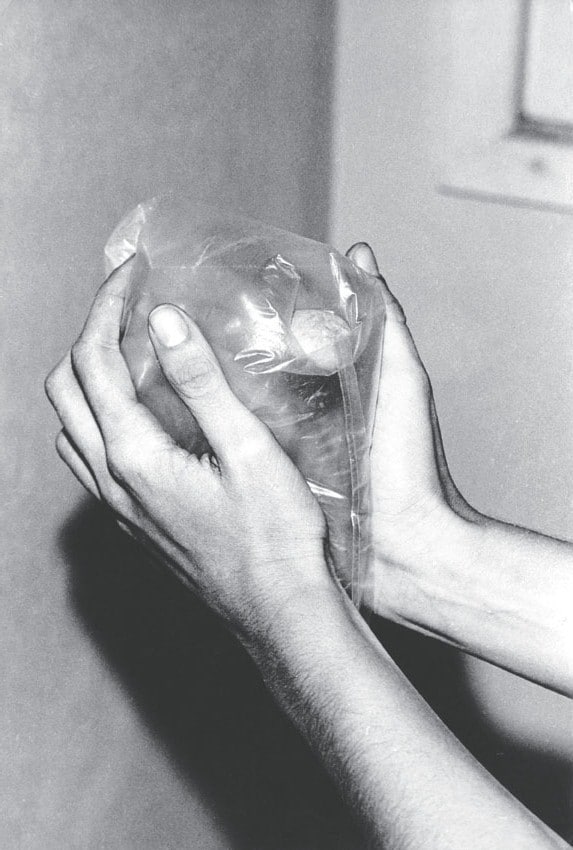
In the months after making Caminhando, Clark herself certainly experienced the feeling of being able to see once again, and so of being truly able to begin. A few years later, in 1966, she was involved in a car accident and fractured a wrist. In a hugely meaningful text of 1973, Reencontrar o significado de nossos gestos rotineiros (To rediscover the meaning of our routine gestures), she recalled that she had had to wrap the hand in a poultice, coating it in “a kind of paste that had to be kept hot” and keeping it “imprisoned in a plastic bag kept in place by an elastic band, forming a sort of watertight sheath. One day I tore off the plastic bag,” Clark continued, “blew it up and sealed it with the elastic band; taking a small stone, I tried to hold it in place by pressing the bag with both hands on one of the points of the air pocket; then I let it be engulfed, thus mimicking an extremely disturbing birth.”43 So she described her first work of “nostalgia of the body,” Pedra e ar(Stone and air, 1966), the piece that would inaugurate her decisive series of relational objects: “sensory masks (smell, sound, touch), garments that condition movement, obliging us to rediscover the feeling of our routine gestures,” as she described them.11Ibid.
I’d like to stress the connection between Clark’s discovery of the density of painting, her opening of its surface to apertures and incisions, cracks and fissures, to the intervals of emptiness that she felt traversing her own body, and this injury to her wrist, the experience of a broken bone that would have brought her to the memory of her own body. An organic line is a line of rupture, a line that bursts into the body of things and marks their separation. A symbolic object—a line, a cut in a surface—may turn itself into a symptom: “it loses its primary identity,” Georges Didi-Huberman writes, “…transgressing the limits of its own semiotic field” in order to function in this case as a metonym for the fractures of the body, or, better, as the signature of the infinite, uncountable interruptions that constitute our existence.12Georges Didi-Huberman, L’Image survivante (Paris: Minuit, 2002), pp. 304–5. The wound to Clark’s hand, however, that opened the way to Pedra e ar did not translate as a representation of a rupture. In other words, the experience of a fracture in her own body—an organic line, a symbol written in her own flesh—made way for a form of reparation: that figure of “an extremely disturbing birth,” that stone, metonym for the body, bubbling up out of the aqueous depth of the plastic bag, and precisely not falling heavily to the floor.
Another sensory object, also realized in 1966, may also be linked to this experience of accident, rupture, and reparation. This is Diálogo de mãos (Dialogue of hands,1966), a bandage connecting two people’s hands, forming a Möbius strip at their wrists. The best-known photograph of this work was made by Clark with the help of the artist Hélio Oiticica, her friend and peer: both hands are visible, simultaneously separate and joined, distanced and connected by a Möbius strip/bandage, as if the line in Caminhando had finally come to mend the wound of the organic line.
To give up painting for a bag of water holding up a stone was the action that so perplexed the young Caetano Veloso and his friend Sônia Castro all those years ago. If holding up that stone revealed a new world, if it was a remedy or help, so was Clark’s holding up her hand next to the hand of another person, as she held up Oiticica’s hand in Diálogo de mãos. There the Möbius strip was literally the poultice, the bandage that embraced the wrist, the dressing that mended the separation of bodies, the signature of the embrace that gives birth to vision. Once again it was a question of two lines, this time incarnated in a body, one’s own and another’s; it was two lines making themselves into a body with a body, a world with a world. It was the caressing line of Butades’s daughter nearing the body of her lover, the infinitessimal line that cannot be divided. It was a poultice, a cloth dressing, like the swelling clay that Butades attached to the outline of a shadow so that presence might manifest in absence, in Clark’s case in the form of a line, a Möbius strip. It was the abyss of the body infiltrating its own shadow, infinitessimally, through another body; it was, as Clark wrote, “this nostalgia of being a wet stone, a stone-being under the shade of a tree, outside time.”13Clark, “Caminhando,” p. 161.
This is the third section of a three-part essay by Luis Pérez-Oramas on the Brazilian artist Lygia Clark, excerpted from the exhibition catalog Lygia Clark: The Abandonment Of Art, 1948-1988, available at the MoMA bookstore. Read the first section here and the second section here.
- 1See Jacqueline Lichtenstein, La Tache aveugle. Essai sur les relations de la peinture et de la sculpture à l’âge modern (Paris: Gallimard, 2003), p. 16.
- 2Clark, fragment (“Sobre o espaço”), 1957. Archives of the Associaçao Cultural “O Mundo de Lygia Clark.”
- 3Clark, “Lecture at the Escola Nacional de Arquitetura, Belo Horizonte, Fall 1956,” p. 54.
- 4Saint Thomas Aquinas, Summa contra Gentiles, 1260s/1270s, book IV, chapter LVII; Summa Theologica, 1265–74, book III, question 60, objection 1. See also Agamben, The Signature of All Things, p. 44.
- 5Agamben, The Signature of All Things, p. 77.
- 6Ibid., p. 78.
- 7Clark, “Letter to Piet Mondrian,” May 1959. Archives of the Associação Cultural “O Mundo de Lygia Clark.” Translation in the present volume, p. 59.
- 8Ibid.
- 9Marcus Aurelius, Meditations, 170–80 A.D., trans. Robin Hard (New York: Oxford University Press, 2011), p. 38.
- 10Michel Foucault, L’Archéologie du savoir, 1969, Eng. trans. as The Archae-ology of Knowledge, trans. M. Sheridan Smith (New York: Pantheon, 1972), p. 145.
- 11Ibid.
- 12Georges Didi-Huberman, L’Image survivante (Paris: Minuit, 2002), pp. 304–5.
- 13Clark, “Caminhando,” p. 161.
